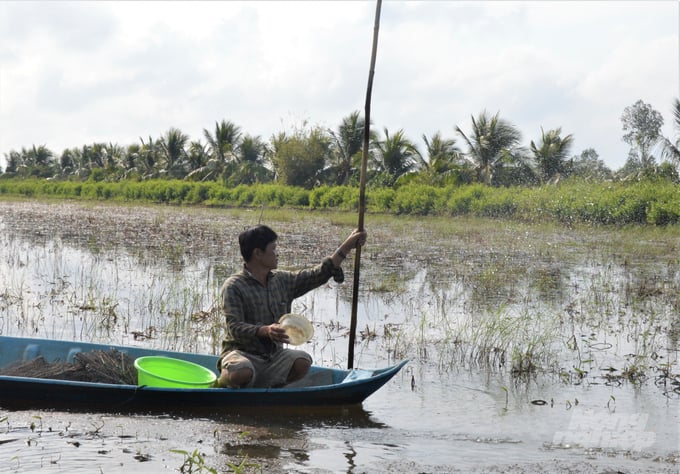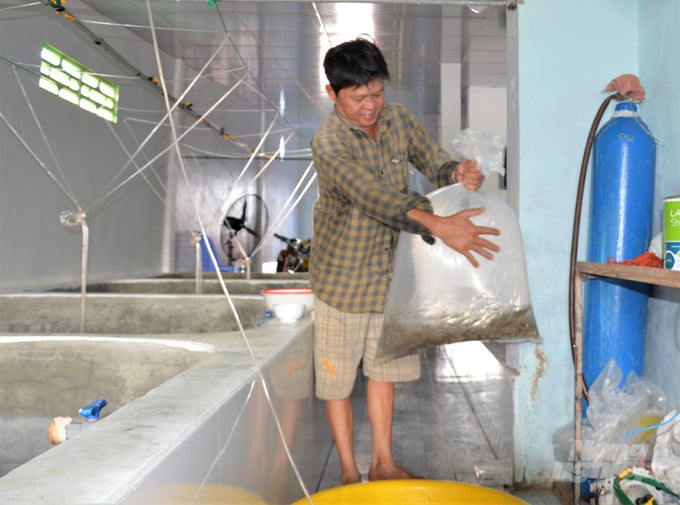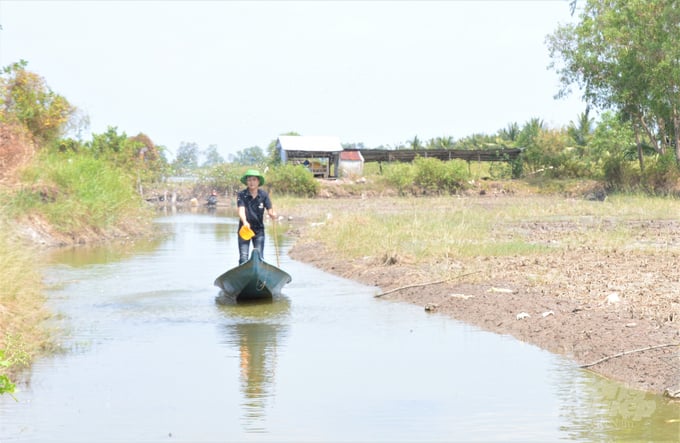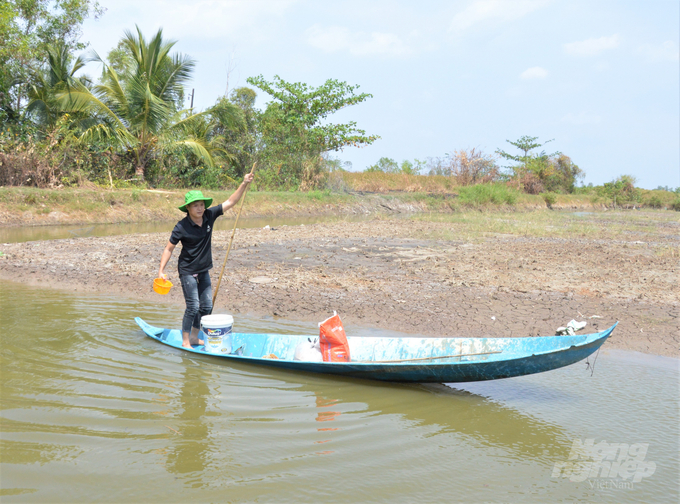June 21, 2025 | 00:57 GMT +7
June 21, 2025 | 00:57 GMT +7
Hotline: 0913.378.918
June 21, 2025 | 00:57 GMT +7
Hotline: 0913.378.918
According to the statistics of Kien Giang Sub-Department of Fisheries, out of nearly 35,000 establishments that are required to register for mariculture establishment codes, there are nearly 9,000 establishments in operation mortgaging the certificate of land use right (referred to as “red notebook” in Vietnamese) to get bank loans. This Is considered a big barrier which slows down the plan to grant the farming area code in accordance with the provisions of the 2017 Law on Fisheries.

Many shrimp farming establishments are mortgaging their “red notebook” for bank loans. Photo: Trung Chanh.
Mr. Kim Hoang Thanh, Director of the Kien Giang Sub-Department of Fisheries, said that the work of issuing identification codes for brackish water shrimp farming establishments in the districts was still slow and had not been completed according to the plan due to certain difficulties.
Statistics from localities show that the province has nearly 9,000 establishments (shrimp farming households) that have not been granted mariculture establishment codes. Nearly 8,770 establishments are waiting for bank branches and credit institutions to provide copies of land use right certificates to carry out the procedures, and 391 establishments do not comply with the issuance of codes.

An Minh has a large number of brackish shrimp farming households, thus needing a variety of identification codes. But because of the complicated situation of Covid-19 in the past few years, it is very difficult to gather the farming households and give guidance on the issuance of codes. Photo: Trung Chanh.
In the case of An Minh district, nearly 50% of establishments are not eligible or are mortgaging “red notebooks” for bank loans, so they have not been able to be granted shrimp farming establishment codes.
Mr. Nguyen Thanh Dien, Deputy Head of the Office of Agriculture and Rural Development of An Minh district said, "According to statistics, there are nearly 16,000 households in the whole district that need to be issued identification codes for brackish water shrimp farming. However, the number of households not eligible to issue identification codes of brackish water shrimp farming is more than 3,400. The number of households borrowing bank loans after mortgaging their land use right certificates is nearly 3,990. In addition, there were 135 cases of non-compliance with code issuance".
Most shrimp farming households have used land use right certificates as collateral for banks and credit institutions to borrow capital for production, so it is difficult to add them to the registration procedure. Some households are not well-aware of the importance of having identification codes for brackish water shrimp farms, which poses a problem for implementation.
Another barrier makes things difficult or even impossible for Kien Giang to issue mariculture establishment codes. There are lands without land use right certificates, disputed land, or invaded land (people grow crops on land that do not belong to them). Another example is that the land is rented. The shrimp farmer is not the owner of the land, and there is no way to contact the real land owner. According to statistics, Kien Giang has more than 7,600 establishments that are not eligible for mariculture establishment codes because of the above reasons.

There are cases when farmers rent land to conduct shrimp farming, but the real land owner is out of reach, making it difficult for local authorities to issue mariculture establishment codes. Photo: Trung Chanh.
According to information from the Office of Agriculture and Rural Development of Hon Dat district (Kien Giang), the total number of shrimp farming households is now 485, located in 7 coastal communes and towns. Through the review, up to 211 farming households are unable to issue identification codes for shrimp farms because they did not have land use right certificates. There are 43 shrimp farming households in My Lam, Binh Son and Soc Son communes not eligible for code issuance because they are not located in the aquaculture development planning area.

In the near future, the competent authorities of Kien Giang will provide guidance on the documents and procedures for people to correct the cadastral records, issue and change the appropriate land use right certificates to meet the requirements for code issuance. Photo: Trung Chanh.
The Office of Agriculture and Rural Development of Hon Dat district has set a key task. From now until the end of 2023, the local agricultural sector will coordinate with the People's Committees of communes to grant more identification codes for brackish water shrimp farming to 56 households, including 23 households in Binh Giang commune, 15 in Binh Son, 12 in Tho Son, and 6 in Linh Huynh. The remaining 23 households will be issued codes in 2024 because they have not completed the land use right certificates.
Translated by Samuel Pham
![Turning wind and rain into action: [9] Digitizing hydrometeorological data in response to climate change](https://t.ex-cdn.com/nongnghiepmoitruong.vn/608w/files/news/2025/06/17/z6704423696987_15fd32ffc26d590d204d520c9dac6786-nongnghiep-165943.jpg)
(VAN) Farmers have begun accessing hydrometeorological applications to adjust their cropping schedules, aiming to ensure productivity and adapt to climate change.
![Turning wind and rain into action: [8] Real-time salinity detection and early warning technology](https://t.ex-cdn.com/nongnghiepmoitruong.vn/608w/files/news/2025/06/17/z6704423696987_15fd32ffc26d590d204d520c9dac6786-nongnghiep-151127.jpg)
(VAN) Thanks to the integration of modern hydrological-hydraulic models, remote sensing technologies, and artificial intelligence, the accuracy of hydrological forecasting has significantly improved.
![Turning wind and rain into action: [7] Early disaster warnings help marine farmers minimize losses](https://t.ex-cdn.com/nongnghiepmoitruong.vn/608w/files/news/2025/06/17/z6704423696987_15fd32ffc26d590d204d520c9dac6786-nongnghiep-142942.jpg)
(VAN) In recent years, thanks to early disaster warnings and forecasting, marine farmers in Khanh Hoa province have been able to reduce risks and losses, thereby improving production efficiency.
![Turning wind and rain into action: [6] ‘Four on-the-spot’ disaster management software](https://t.ex-cdn.com/nongnghiepmoitruong.vn/608w/files/news/2025/06/17/e5a48259d6a262fc3bb3-nongnghiep-183800.jpg)
(VAN) By simply activating the scenario on the disaster management software, the relevant authorities immediately know how many households need to be evacuated, where to evacuate them to, and by what means of transportation…
![Turning wind and rain into action: [5] Hue applies modern technology in disaster forecasting](https://t.ex-cdn.com/nongnghiepmoitruong.vn/608w/files/news/2025/06/17/z6704423696987_15fd32ffc26d590d204d520c9dac6786-nongnghiep-093938.jpg)
(VAN) In Hue city, modern technology has recently been applied in meteorological and hydrological forecasting and warning, helping to reduce the damage caused by natural disasters.

(VAN) A cutting-edge farming technique being implemented on an experimental ranch in Arizona's Sonoran Desert has already saved a billion gallons of water over five years, according to Civil Eats.

(VAN) Poultry and pig production and the environment can be boosted through enhanced water technology, according to new research.